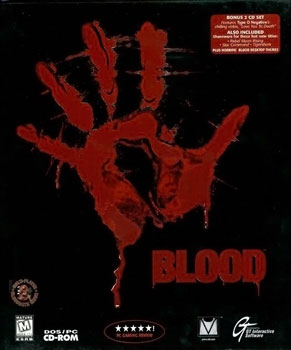 Films such as The Cabin in the Woods are often described as “a love letter to horror.” Monolith’s 1997 first person shooter Blood is more like a rambling, 50 page Unabomber manifesto stuffed into horror’s mailbox at 2:00am, complete with the final line “ps: nice view thru yr bedroom window ;)”. Conceptually it’s one of most ridiculous and nebbish games ever made: the dialogue consists of groan-worthy riffs on famous horror movies, the levels are themed off places like the Overlook Hotel and Crystal Lake, the game shoves references to Lovecraft and George Romero under your face with such obsessive frequency that you almost want to pat it on the shoulder and say “Relax, I get it. Stop trying so hard.”.
Films such as The Cabin in the Woods are often described as “a love letter to horror.” Monolith’s 1997 first person shooter Blood is more like a rambling, 50 page Unabomber manifesto stuffed into horror’s mailbox at 2:00am, complete with the final line “ps: nice view thru yr bedroom window ;)”. Conceptually it’s one of most ridiculous and nebbish games ever made: the dialogue consists of groan-worthy riffs on famous horror movies, the levels are themed off places like the Overlook Hotel and Crystal Lake, the game shoves references to Lovecraft and George Romero under your face with such obsessive frequency that you almost want to pat it on the shoulder and say “Relax, I get it. Stop trying so hard.”.
But it’s also one of the most fun shooters ever made. There’s just no cohesive direction to any of it, and strangely, that completely works.
You have 1) a brainless “shoot everything that moves” gameplay, 2) paired with a complicated set of RPG -style damage modifiers (as a simple example, stone gargoyles repel fire attacks). You have 1) a nonsensical throwaway plot about an old west gunfighter (with anachronisms galore), and 2) a very detailed mythos, right down to the fact that the enemy cultists speak a constructed language (there was a dictionary on the now-defunct Blood site, revealing said language to be the product of hurling Sanskrit and Latin at each other in a Participle Accelerator.) You have 1) shitty graphics (the Build engine was dated in 1996, and even more so in 1997), and 2) fairly groundbreaking use of 3D voxel imaging (for tombstones and such). Blood’s an anomaly.
The game’s a mess, in the best way possible. It’s like it was made by two different teams living on two different continents who could only communicate by carrier pidgeon. “Throw a bunch of interesting ideas together” seldom works, but here’s the exception.
I’ve played through it several times, at various difficulty levels, and I still find it capricious, challenging, and occasionally brilliant. The Build Engine isn’t the prettiest whore on the waterfront, but it allows for destructible/deformable environments and the game takes those features and runs like they’re a pair of scissors. E1M3, “The Phantom Express”, takes place on board a moving train – it’s stunning as a visual effect, and the level design perfectly complements it: you have to fight tense gunbattles in narrow train corridors, etc. The only bad thing is that none of the later levels quite match it in creativity.
The weapons are savage and visceral (though I never figured out exactly how the voodoo doll work), and the level design fun, flowing, and filled with endearing human touches. Duke Nukem 3D was the anti-Quake. This is the antier-Quake. This is the final and complete triumph of content over technology, and nobody in gaming realised it, either then or now.
Not even Monolith did – Blood II was an inexplicable attempt at remaking this game with zero character or charm. And of course, the game still has a modding community.
Blood isn’t perfect. The final boss is the easiest one in the game. The weapons aren’t balanced all that well (generally, the cooler a weapon seems, the less useful it is in the game) and some of the enemies are truly ridiculous bullet sponges. It’s bimodal nature means it has daring creativity paired with cloddish FPS cliches – there’s the old “shoot a crack in the wall to reveal a secret area” wheeze…again…and again…
But it’s classic, and the rarest type of game: one that is impervious to time. To preserve a human body, you generally extract all eight litres of blood – and I guess this is where it all ends up. Duke Nukem 3D came out a year before and laid the ground for this type of game (gory violence + campy irreverent humor), but between the two of them, THIS is the one to play first, and perhaps last.
No Comments »
Comments are moderated and may take up to 24 hours to appear.
No comments yet.
